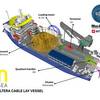Report: Ship Delivery Underperformance in 2010
Industry concerns over the glut of newbuilding deliveries last year may have been overplayed as the three major shipping market segments - dry bulk, container and tanker - avoided significant oversupply, according to figures released by Braemar Seascope.
The London-listed shipbroker compared the orderbook at the end of 2009 with the full-year delivery statistics for 2010. The gap between what was anticipated to deliver and what actually delivered offers an insight into the development of the shipbuilding and freight markets.
The difference between the orderbook schedule and actuality in 2010 was a function of technical underperformance at certain shipyards and the fall-out of the credit crunch. Some orders were cancelled while, in many cases, ship owners renegotiated delivery dates.
Dry bulk deliveries were scheduled to total 1,400 ships of 113 million dwt last year. In the event, 950 ships of 78 m dwt were delivered: a shortfall of 31%. Braemar Seascope had anticipated the delivery of some 270 Capesize bulkers (over 120,000 dwt) in 2010. In the event, 195 delivered - still one nearly every working day of the year but 27% less than the schedule at the start of 2010.
The orderbook at start of 2011 suggests that 262 Capesize ships could deliver this year, though Braemar Seascope's London-based Research Manager Mark Williams says: "It's quite likely that the freight market outlook will encourage further delays in deliveries. It will not surprise us if as many as a quarter of this year's anticipated deliveries don't turn up by December this year. The delays may prolong the downturn but equally they could allow demand to catch up with supply during the recovery from the 2009 recession."
Braemar Seascope expected crude oil and oil products tanker deliveries to total nearly 400 ships last year, totalling 51m dwt. In the event, 290 ships delivered, totalling 37m dwt, representing a shortfall of 27%. The biggest shortfall among crude tankers was in the Suezmax segment, where 36 out of an expected 57 ships delivered, a shortfall of 37%. In the smaller size, only 9 out of the 22 handy tankers destined for international trading were actually delivered in 2010. According to Mark Williams, these figures exclude Chinese built ships intended for Chinese domestic trades.
In 2011, almost 80 VLCC deliveries are scheduled, but after a 26% shortfall in 2010 deliveries, the segment might escape the worst effects of oversupply if demand continues to hold up in the face of $90+ per barrel oil. Braemar Seascope, one of the world's leading chartering brokers, anticipates that not all the 60 Suezmaxes that are due for delivery in 2011 will enter the market on time, helping to constrain the oversupply in this sector of the market.
The fast-growing containership fleet was braced for more than 350 new ships in 2010, of which 80 were over 7,500 teu. In fact, 290 ships of 1.35m teu delivered compared to expectations of 20% more capacity - 1.7m teu. Braemar Seascope points out that these raw supply figures do not account for slow steaming, lay-up and other forms of supply management which continue to support freight rates in the boxship sector. Williams notes that after a 27% shortfall in the number of expected 2010 deliveries, we can expect more underperformance this year, when 222 boxships of 1.47m teu are due for delivery. "That could make the difference between red and black ink in the accounts for many owners," concludes Williams.














